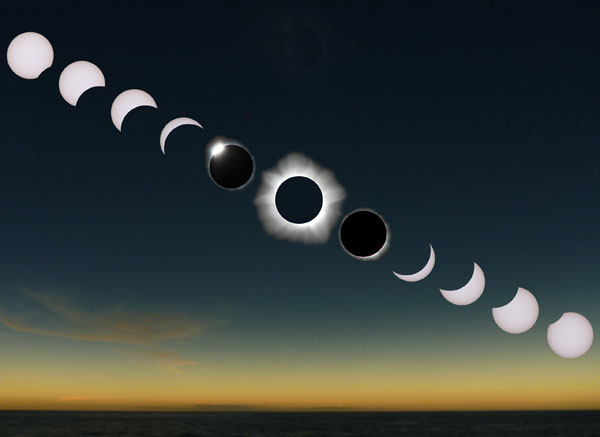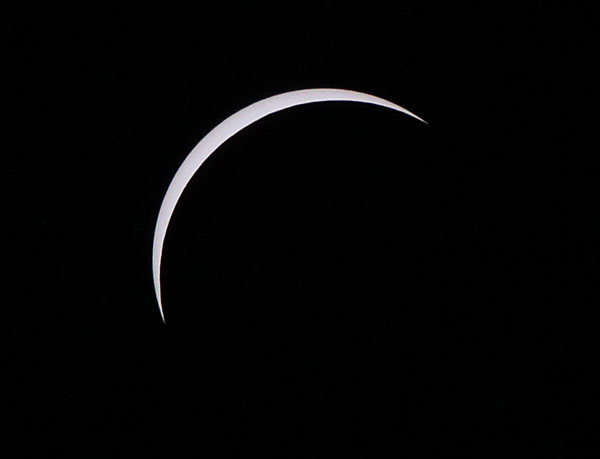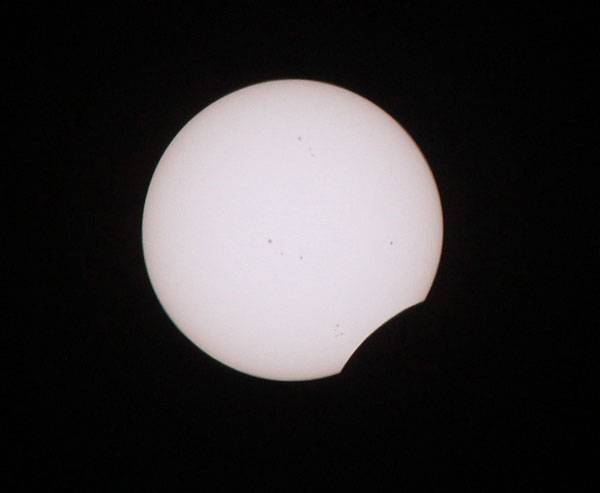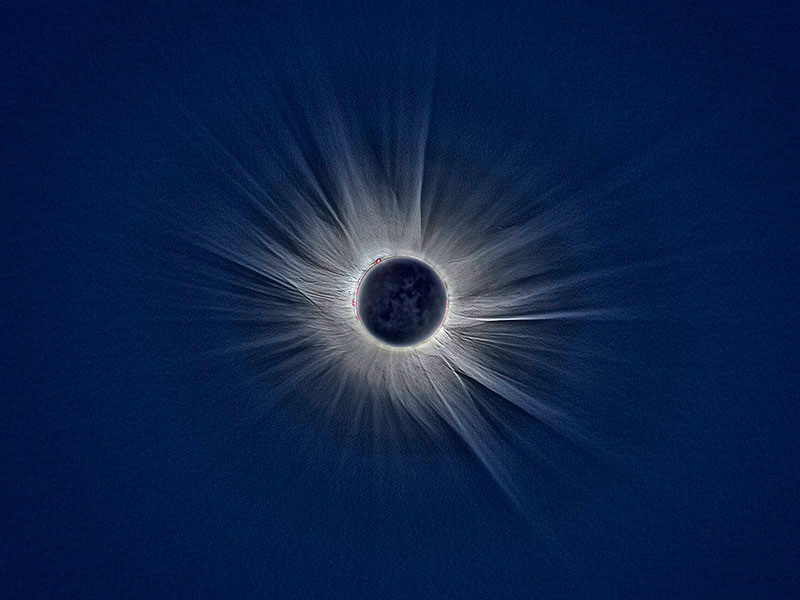Look for these astronomical and Earthbound phenomena during the total solar eclipse on April 8, 2024.
On April 8, 2024, the umbra (dark center) of the Moon’s shadow will race across central Mexico, 14 U.S. states, and the Canadian Maritimes, giving a dramatic look at the solar corona to anyone standing inside the path of totality. Meanwhile the rest of North America, Central America, and the Caribbean will experience a partial eclipse.
If the sky is clear and you can get yourself inside the narrow path of totality (check here for an interactive map and times), you're guaranteed an intense experience. The brief minutes of total eclipse give you the chance to witness some rare phenomena. But there are other unusual astronomical sights to watch for before and after totality, or if, like many, you’ll be in the much wider partial-eclipse zone.

Rick Fienberg / TravelQuest International / Wilderness Travel
The entire event takes about 2 hours, 40 minutes. Here's a celestial schedule of what to look for.
First Contact
The partial phase of the eclipse begins when the Moon’s edge first appears to touch the Sun's disk, an event known as first contact. It may take a minute or two after the exact time for you to begin to notice a slight dent in the Sun’s edge: on the Sun’s celestial-western side.
If you have access to a safely filtered telescope, look for irregularities on the Moon’s edge compared to the perfect smoothness of the Sun’s edge. You’re seeing lunar hills and valleys in profile. And given that it's solar maximum there should be several sunspots visible. If one is big enough, can you see that its central part is not black but gray when compared to the blackness of the Moon?
Even if you don’t have a telescope, you can track the Moon’s progress as it moves farther onto the Sun’s face over the next hour or so using solar eclipse safety glasses. Another fun and safe way is to hold a colander above a white sheet of paper or card: You will see crescent Suns in place of the usual small circles of light.
As the eclipse grows deep, watch for the sky to gradually turn a darker blue and the day to begin to cool.
10 Minutes Before Totality

Rick Fienberg / TravelQuest International / Wilderness Travel
By now the crescent Sun has dwindled to a sliver when viewed through your filter, and the daylight will be noticeably dimmer and silvery. Temperatures have started to cool.
If there's a uniform surface around, such as sand, a white sheet, or the side of a vehicle, you may see wavy “shadow bands” in the final few minutes, as the thin slit of sunlight is refracted through the little heat waves that are always present in Earth's atmosphere — the same ones that make stars twinkle and high-power telescopic images shimmer.
As you wait for totality, look for bright planets and stars to emerge. The two brightest planets, Venus and Jupiter, will sandwich the Sun: Venus will appear some 14° southwest of the Sun, while higher up and about twice as far from the Sun's other side you might see Jupiter.
30 Seconds Before Totality
In the few seconds before second contact and totality, the fast-falling twilight casts sharp shadows, and the day turns noticeably cooler. Often a breeze springs up. This is when wildlife gets confused; birds roost, mosquitoes and bats may appear, and flowers close.
The sky toward the western horizon darkens — and as that darkness sweeps toward you events take on a colossal and unstoppable feel.
Baily's Beads & Diamond Ring #1
Keep looking through your eclipse filters, and you may see the razor-thin solar crescent break up into arcs and beads, as sunlight shines through valleys along the Moon’s leading edge. (They're best seen with a safely filtered telescope or pair of binoculars.) These are called Baily's beads. As they contract to nothing, a single, beautiful bead may dazzle like a diamond ring on the top-left edge of the Moon for a second. As it fades, take off your eclipse glasses: The total eclipse has begun.

Left: Reinhold Wittich; Right: Rick Fienberg / TravelQuest International / Wilderness Travel
Second Contact: Totality
The solar corona reveals itself in full glory: a filamentary halo of fine white streaks, often overlapping. If you have binoculars you're in for a real treat; there's probably no more captivating view in binocular astronomy than a closeup of the solar corona's intricate structure. Scan the halo with your eclipse filters removed — but first concentrate on its top-left inner edge, right above the Moon's advancing edge.
Start of totality: Chromosphere at Bottom-left
Check for a brilliant pinky-red layer, the Sun's chromosphere, visible when the last of the Sun’s surface fades away. Look for any solar prominences — tiny, bright red spots, loops or arcs. This layer will quickly thin and disappear as the Moon advances past it.
Mid-totality: Solar Corona Peaks
Astronomers will be awaiting the midway point of totality (about one minute in, depending on where you are) to most clearly see the corona’s size and shape. We’re in solar maximum — the Sun's most active stage in its 11-year activity cycle — so the corona may appear large with streamers extending in all directions.
And although it's hard to get your eyes away from the “hole in the sky,” turn through 360° to see how strange the sky and world now look. Be sure to glance roughly 10° above the south-southwestern horizon, where Saturn appears little more than a degree to the upper left of Mars, both shining at nearly the same brightness (+1.1 and +1.2, respectively).
End of Totality: Chromosphere to Bottom-right
A few seconds before the end of totality, the chromosphere will re-emerge from behind the bottom-right of the Moon: another opportunity to see prominences with binoculars (though they may also be visible to the naked eye). Then put down your binoculars and put their solar filters back on. But don't spend too much time looking down, because . . .
Diamond Ring #2 & Baily's Beads
A second Diamond Ring may appear in the same bottom-right area, followed by Baily's beads. As soon as the beads appear, put your eclipse glasses back on. If there are wispy clouds nearby, they often go pink.

Rick Fienberg / TravelQuest International / Wilderness Travel
Third & Fourth Contact
With third contact achieved, look briefly through your eclipse glasses at the narrowest of crescent Suns. Now is the time to look again for any shadow bands, and to once again project the crescent Sun as the partial eclipse recedes over the next hour or so until fourth contact, when the Moon departs from the Sun's disk, as if nothing had ever happened.
Observers will be left with only one question: when is the next eclipse?
For more eclipse information and resources, visit our Total Solar Eclipse 2024 page!
 0
0











Comments
You must be logged in to post a comment.